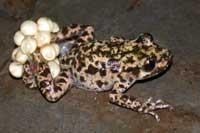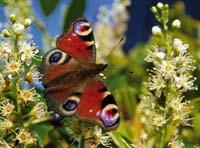Losses in the “backbone” of nature
2010/11/14 Aulestiarte Lete, Izaro - Elhuyar Zientziaren Komunikazioa

At the Biodiversity Summit, several governments have discussed measures to protect natural and vital diversity. The report by 174 experts from 38 countries around the world, 115 organizations, has been released there, and Science has also released the data.
Data on 25,780 species from the Red List of Threatened Species have been used to analyze the status of vertebrates and the situation has changed over time. It has been highlighted year after year that 50 species of birds, amphibians and mammals present a higher risk of extinction, which is due to short forests, overexploitation, agricultural extensions and invasive alien species. Well, one in five vertebrates is in danger of extinction: that of amphibians is the worst case, with 41% of them in danger of extinction and up to 13% of birds.

Conservation measures have significantly improved the state of peat peat ( Mustela nigripes). (Photo: Wendy Shattil and Bob Rozinski).
“The backbone of biodiversity is deteriorating,” said Edward O of Harvard University. Wilson ecologists and writers. “A small step on the Red List is a big step to extinction. This is a small window of all the losses we experience around the world.”
There are other levels of diversity, but biodiversity is mostly represented by the number of species. In this sense, Southeast Asia has suffered in recent times the greatest losses due, in large part, to commercial practices of hardwood, agricultural reconversions of rice fields and unsustainable hunting of oil palm for export. Areas of Central America, tropical Andes and Australia have also suffered significant damage.
On the other hand, it is worth mentioning the data from other recent studies. As we explained a few weeks ago, some researchers have warned that the biodiversity of river habitats around the world is threatened in 65% of cases. Another study highlights that 22% of plants are also in danger of extinction and another 10% could be in the same situation shortly if no action is taken.
Better, but not enough
The report presented in Nagoya confirms the results of many previous studies aimed at a decrease in biodiversity. But it is also the first to recognize the positive effect of the work carried out for the protection of species, which somehow does. According to the researchers, the status of biodiversity would be 20% worse if it were not for conservation measures. 64 species of mammals, birds and amphibians have benefited from this “conservation success” and the best results have come hand in hand with efforts against invasive alien species. If there is anything!

In general, the most unfavorable situation is amphibians, with 41% endangered. (Photo: Richard A. Griffiths).
The problem is that the objectives and challenges of the agreed international agreements to reduce biodiversity loss by 2010 have not been met. The commitments made and the steps taken have served, but the situation has been so serious that it has not been enough. Those in Nagoya believe that measures to address losses expected by 2020 should be taken "immediately." This is a global challenge that requires “collaboration” and “efficiency”.
Published in 7K.

Gai honi buruzko eduki gehiago
Elhuyarrek garatutako teknologia






